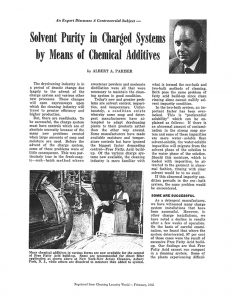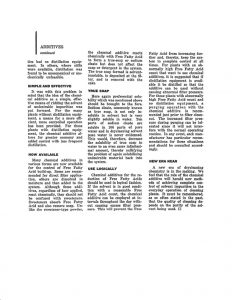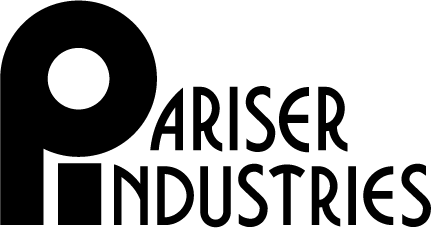In February 1955, Cleaning Laundry World published an article written by Pariser Industries founder Albert Pariser. Below please find that recreated article alongside the reprinted publication.
Solvent Purity in Charged Systems by Means of Chemical Additives
by Albert A. Pariser
The dry-cleaning industry is in a period of drastic change due largely to the advent of the charge system and various other new processes. These changes will open expressways upon which the cleaning industry will travel to greater efficiency and higher production.
But, there are roadblocks. To be successful, the charge system must have controls which are of absolute necessity because of the many new problems created when large amounts of soap and moisture are used. Before the advent of the charge system, some of these problems were of little consequence. This was particularly true in the fresh-so-to-each-batch method where sweetener powders and moderate distillation were all that were necessary to maintain the cleaning system in good condition.
Today’s new and greater problems are solvent control, impurities, and temperature. Unfortunately, a condition exists whereby some soap and detergent manufacturers have attempted to adapt dry cleaning plants to their products rather than the other way around. Some manufacturers have made available moisture and temperature controls but have ignored the biggest factor demanding control-Free Fatty, Acid build-up. Of the various charge systems now available, the cleaning industry is more familiar with what is termed the on-bath and two-bath methods of cleaning. Both pose the same problem of fatty acid build-up since clean rinsing alone cannot nullify solvent impurity condition.
In the two-bath system, an important factor has been overlooked. This is “preferential solubility” which can be explained as follows: If there is an abnormal amount of contamination in the strong soap system and some of these impurities are more water-soluble than solvent-soluble, the water-soluble impurities will migrate from the solvent phase of the solution to the water phase of the solution. Should this moisture, which is loaded with impurities, be attracted to the garment in abnormal fashion, rinsing with clear solvent would be to no avail.
If this abnormal impurity condition prevails in the one-bath system, the same problem would be encountered.
SOME ARE SUCCESSFUL
As a detergent manufacturer, we have witnessed many charge system installations that have been successful. However, in other charge installations, we have noted a decline in results after a few weeks of operation. On the basis of careful examination, we found that where the system deteriorated, 97 percent of those cases were the result of excessive Free Fatty Acid build-up. Our findings are that Free Fatty Acid cannot run rampant in a cleaning system. Some of the plants experiencing difficulties had no distillation equipment. In others, where stills were available, distillation was found to be uneconomical or mechanically unfeasible.
SIMPLE AND EFFECTIVE
It was with this problem in mind that the idea of the chemical additive as a simple, effective means of ridding the solvent of undesirable impurities was put forward. For the many plants without distillation equipment, a means for a more efficient, more controlled operation has been provided. For those plants with distillation equipment, the chemical additive allows for a greater economy and added control with less frequent distillation.
NOW AVAILABLE
Many chemical additives in various forms are now available for the control of Free Fatty Acid build-up. Some are recommended for direct filter application, others are dissolved in moisture and then added to the system. Although these additives, regardless of how applied, react chemically, they should not be confused with sweeteners. Sweeteners absorb Free Fatty Acid and also remove soap. Unlike the sweetener-type powder, the chemical additive reacts chemically with Free Fatty Acid to form a true-soap or sodium oleate but does not affect the soap or detergent in the system. The true soap formed in solvent-insoluble, is deposited at the filter, and is removed with the cake.
TRUE SOAP
Here again preferential solubility which was mentioned above should be brought to the fore. Sodium oleate, commonly known as true soap, is not only insoluble in solvent but is very slightly soluble in water. Ten part of sodium oleate are soluble in 100 parts of pure water and in dry-cleaning solvent pure water is never evidenced. This would, therefore, decrease the solubility of true soap in water to an even more infinitesimal amount, thereby nullifying the problem of again solubilizing undesirable material back into the system.
USE LOGICALLY
Chemical additives for the reduction of Free Fatty Acids should be used in logical fashion. If the solvent is in good condition with a reasonable Free Fatty Acid count, the chemical additive can be employed at intervals throughout the day without causing excess filter pressure. This will prevent the Free Fatty Acid from increasing further and, thereby, keep the system in complete control at all times. For plants with an abnormally high Free Fatty Acid count that want to use chemical additives, it is suggested that if distillation equipment is available it be distilled so that the additive can be used without causing abnormal filter pressure. For the plants with abnormally high Free Fatty Acid count and no distillation equipment, a purging operation with the chemical additive is recommended just prior to filter clean-out. The increased filter pressure during purging can be tolerated since it will not interfere with the normal operating routine. In any event, each manufacturer has particular recommendations for these situations and should be consulted accordingly.
NEW ERA NEAR
A new era of dry-cleaning chemistry is in the making. We feel that the role of the chemical additive will herald new methods of achieving complete control of solvent impurities in the everyday operation of cleaning plants. It must be remembered, as so often stated in the past, that the quality of cleaning depends on the purity of the solvent being used.
